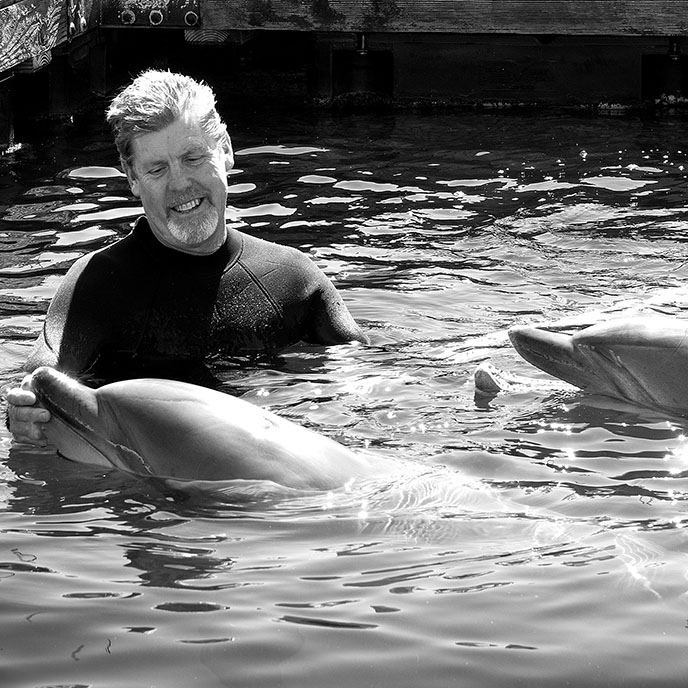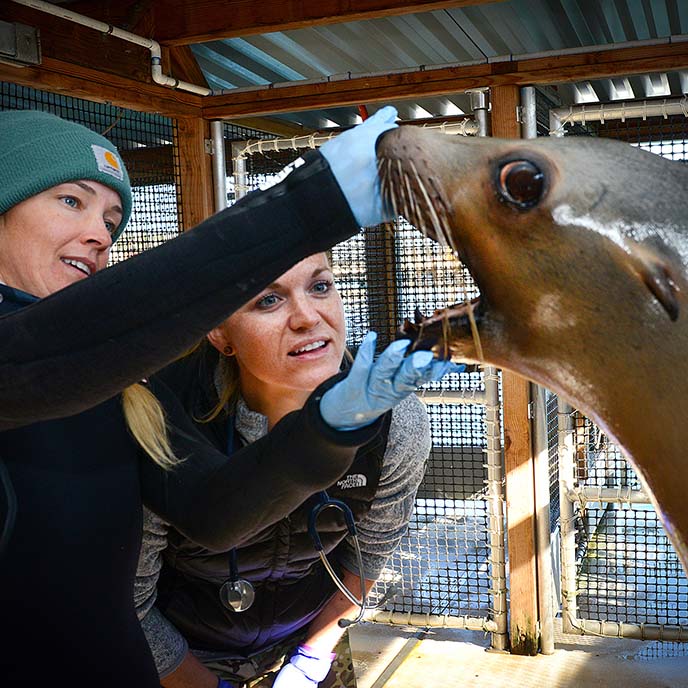

How did a pair of Iowa State College of Veterinary Medicine graduates wind up working together in the U.S. Navy’s Marine Mammal Program in San Diego?
It sure wasn’t a straight path.
For Dr. Eric Jensen (’90), his journey to becoming a marine mammal veterinarian began at age 6 or 7.
“My dad took me to a mall parking lot where a group had set up a pool and were charging admission to see a dolphin,” Jensen recalls. “When I looked in, the dolphin was just floating, and I thought ‘someone needs to take care of that animal.’
“Over the years, I’ve spent a lot of time thinking about that dolphin. I kept going back and thinking, who was taking care of those animals?”
Dr. Abby McClain (’16) started her journey to the U.S. Navy’s Marine Mammal Program just as young.
“I’ve always had a love affair with the ocean,” she says. “Instead of boy band posters growing up, I had surfing posters.”
When McClain and her family traveled to San Diego to go to Sea World, the experience exposed the landlocked Iowa girl to the sea.
“I just fell in love with it, and I wanted to combine medicine and the ocean. Today I have the opportunity to take care of the most magnificent animals in the world.”
Both Jensen and McClain learned early on it would take more than just a desire and a veterinary education to work with marine mammals. And even though they attended veterinary school decades apart, both said their dreams were encouraged by their Iowa State instructors.
While Sea World played an important role in McClain’s career, it was another theme park that Jensen relied on to get experience. He had a friend who was working at Disney’s EPCOT in the Living Seas exhibit who encouraged him to go to Florida.
A college internship at the University of Hawaii’s Kewalo Basin Marine Mammal Laboratory was the beginning for Jensen. After that it was a summer job at Marine Life Oceanarium in Gulfport, MS, and a preceptorship at a small animal/exotic practice in Central Florida that eventually led to a job opportunity back at that Mississippi theme park.
McClain took a mixed animal track during her fourth year in order to learn as many species as possible. At the time, it also provided her with several rotations outside the Lloyd Veterinary Medical Center.
She took immediate advantage.
“I really worked hard to build my resume,” she said. “I did two aquatic preceptorships, along with a shelter medicine and zoo rotation. I just wanted to get my foot in the door and be as competitive as possible if the door wasn’t open for me. I used every bit of spare time I had in my fourth year to get more experience.”
But a marine mammal job after graduation wasn’t forthcoming and McClain did a small animal rotating internship at a Boston veterinary hospital, Angell Animal Medical Center.
“I wanted to get as much experience as possible,” she said. “The internship made me a better veterinarian.”
It wasn’t easy though.
“That was the hardest year not doing what I wanted to do as a veterinarian,” she said. “I had a few setbacks, but I continued and would volunteer to take all of the exotic animals that came through the emergency room.
“I never gave up on my dream.”
That’s important Jensen says for other veterinarians who wish to work with marine mammals. He readily admits there are few opportunities in this field.
“I never had a Plan B to fall back on,” he said. “You have to have a lot of patience and perseverance to find a career in marine mammal medicine.”
While in Mississippi, Jensen worked with dolphins and sea lions at zoos and amusement parks across the country. After three years he moved to Orlando, FL, and was employed at a small animal and exotic clinic that also consulted for Disney, Universal Studios, and a marine mammal
facility in the Florida Keys.
While he enjoyed the work, he knew his ultimate goal was to work with the U.S. Navy Marine Mammal Program and Dr. Sam Ridgway, the “Dolphin Doctor.”
“I wrote a few research proposals for the Navy, and I was lucky to get a call from Dr. Ridgway asking me to be a contract veterinarian,” Jensen said.
The only problem was the offer was for 30 days only with a possibility of renewal. Jensen took a chance, pulled up stakes in Orlando and headed to San Diego.
“I worked on 30-day contracts for the next 12 months,” he recalled, “before I transitioned to working full time for a Navy contractor and eventually becoming a civil servant.
“In this line of work, you do what you have to do,” Jensen continued.
“I was young enough, had no family. It was just me and my dog. I thought if I came out here and poured my heart into the job, they wouldn’t
kick me out.”
Eventually McClain also made it out to San Diego and was doing a fellowship at the National Marine Mammal Foundation and Navy Marine Mammal Program. She met Jensen but didn’t realize he was a fellow Iowa State veterinary graduate.
Today, the two work together, Jensen as a civil servant, McClain as a civilian contractor for the Navy at the Navy Marine Mammal Program. It’s a job both love.
The U.S. Navy Marine Mammal Program has a long history of teaming with marine mammals – principally bottlenose dolphins and California sea lions, dating back to the late 1950s. It trains and works alongside more than 120 animals to perform tasks such as ship and harbor protection, mine detection and clearance, and equipment recovery.
The animals, located in San Diego, Washington, and Georgia, are cared by Jensen, McClain and their fellow veterinarians, veterinary technicians, animal trainers, and supporting staff.
“We provide the highest quality of care to the animals as called out for in a Secretary of Navy instruction,” Jensen said.
For years, Jensen helped provide the day-to-day care of the animals as the program’s managing veterinarian. Today he is the program’s Senior Scientist for Animal Care. McClain has stepped into some of his former role working daily with the animals.
“I do miss working with other species, but it is nice to get to know two species inside and out like I do these,” McClain said.
“I always get chills when I talk about being a veterinarian, especially when I discuss being an advocate for our animals. I feel a responsibility because they rely on us to advocate for them and be their voice.”
“I’ve had the opportunity to work here since 1994,” Jensen said. “I have a long relationship with many of these animals. I’ve been blessed to see the care of all of our animals continue to get better every year.”
